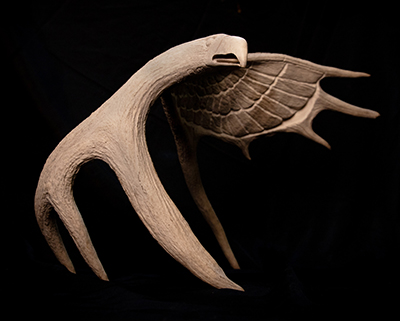By Anita Rathje
A stunning carving by Esk’etemc (Alkali Lake) artist Wilfred Robbins Sr. will take centre stage at the opening of TRU’s Williams Lake commencement ceremonies starting this May and for years to come.
Robbins is the son of Duncan and Lottie Robbins and comes from the hereditary chief bloodline. He carries an abundance of knowledge of Secwépemc culture and traditions that he is proud to preserve and pass down through both his craftsmanship and way of life.
Carved from a single piece of moose antler, the mace portrays a bald eagle in flight. Robbins chose the bald eagle, Spel̓qwéqs, for its symbolism as a messenger, for the Secwépemc and for Indigenous peoples across North America.
“In our culture we honour the four: the ones that crawl, the ones that swim, the ones that fly and the ones that walk. We use the eagle because it’s the highest-flying bird. When we pray, it takes our messages up, that’s how we think about it,” he says.
 Robbins drew his inspiration for the eagle design from the moose antler itself, letting the shape of the antler speak to him. He worked without drawings, following a vision in his mind’s eye.
Robbins drew his inspiration for the eagle design from the moose antler itself, letting the shape of the antler speak to him. He worked without drawings, following a vision in his mind’s eye.
“I just look at the antler and see what it looks like and then I start figuring where pieces go and then I start carving.”
He first roughs out the work using a saw, then shapes and smooths with a sanding tool before carving features.
“A lot of the work I do, I start with the eyes first. The last piece I do is the tongue on the inside — that’s the hardest part.”
Learning from others
A self-taught carver since his time at St. Joseph’s Indian Residential School, Robbins switched materials from wood to antler about 20 years ago, after watching antler carvers work during Kamloopa powwows.
“I saw this one guy carving, so I sat there all through the powwow, just watching him,” he says. “Maybe a year or two later, there’s another carver there doing the same kind of work, so I sat there and watched him too for three days, instead of watching the powwow. He was a good teacher, he’d do work and he’d show me tricks.”
After those initial demonstrations, Robbins went home and had success carving his first pieces. He has been widely admired for his unique art ever since. Community members bring him moose antlers they collect when they’re out in the bush, and he selects for just the right age, neither too damp nor too brittle. His carvings range in size from small pendants to pieces that use an entire antler up to two feet wide.
Working steadily, a carving the size of the mace might take him three days, but he more often works two hours at a time, returning to pieces in short stints over many days. Unlike wood, antler carving is worked in the round with a constant grip on the piece, and the artist moves and turns with it.
In addition to being featured every spring at the Williams Lake Commencement ceremony, the mace will be displayed year-round on campus. Having his art exhibited is a first for Robbins.
“I haven’t really put them on display anywhere, this the first time. It’s an honour for me for TRU to use my piece.”
TRU Williams Lake students, faculty and staff celebrate Commencement 2025 on Friday, May 30 at 2 p.m. with friends and family in attendance.

